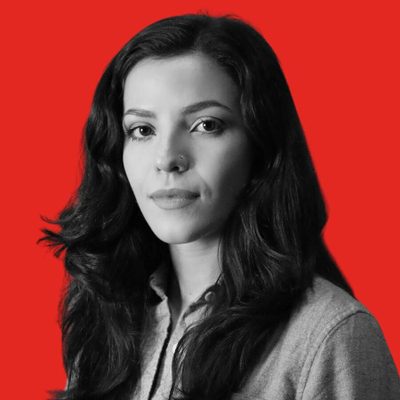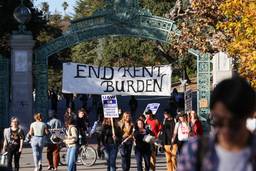A Virtual Charter School Company Says Covid-19 Is the ‘Tailwind’ It’s Been Waiting For
Critics say online learning is failing low-income students. But some for-profit companies are pushing to make it the new normal.
Indigo Olivier

When schools nationwide began closing their doors this spring as the result of Covid-19, many students, parents and teachers felt stress and uncertainty. Online education companies saw an opportunity.
On its most recent quarterly earnings call, Timothy Medina, chief financial executive for virtual charter school operator K12 Inc., said, “We believe the effects of Covid-19 will be a lasting tailwind to online education.”
The company was founded in 2000 by former Wall Street investment banker and McKinsey & Co. consultant Ron Packard, and Education Secretary Betsy DeVos was among the early investors. Since then, K12 has grown into one of the largest for-profit education companies in the world, with revenue topping $1 billion last year.
Now, amid uncertainty about the future of in-person education, the company sees an opportunity to extend its reach even further. K12 has been involved in targeted lobbying campaigns through the American Legislative Exchange Council for nearly two decades, and company executives suggested during the earnings call that they have been working with state legislators and school districts to expand the market for online learning this fall. They’ve also worked with the Heritage Foundation, a conservative think tank, to draft policy recommendations on Covid-19 recovery efforts.
K12 operates more than 70 online schools, the majority of them tuition-free and publicly funded through partnerships with school districts. K12 tuition-free online public schools account for nearly 30% of all virtual school enrollments in the country. The company’s Destinations Career Academies, which are available in all 50 states, are narrowing in on the workforce training market.
K12 executives say that interest in their services has surged in recent months. “When the pandemic first started to impact brick-and-mortar schools, our phones began to ring off the hook,” Nate Davis, CEO of K12 Inc., said on the earnings call. The company is currently running more than 400 active Facebook ads promoting its virtual school services.
An even bigger opportunity may present itself as some states consider taking their school systems entirely online in the fall. K12 already leads in virtual school enrollments in Alabama, where it opened a Destinations Career Academy earlier this school year and has operated the Alabama Virtual Academy since 2015. Alabama recently opened a request for proposals for the creation of a statewide virtual school, making it the seventh state in the nation to offer full-time classes for grades K-12.
Ken Schwartz, a spokesperson for K12, confirmed that the company submitted a proposal, along with a number of other vendors.
“As you read in the news just about every day, parents nationwide are concerned about the impact Covid will have on their child’s future education,” said Schwartz. “K12-powered schools are available in 30 states and D.C. and we are definitely seeing increased interest in options for these students.”
A high-tech reform that’s leaving students behind
Since first launching in 1995, virtual schooling has been promoted as a necessary reform that would bring an otherwise failing school system into the 21st century.
“We already have the 21st-century technology to bridge the gap between the classroom and the workplace, and more importantly to close the divide between the haves and the have-nots,” wrote K12 Senior Vice President Leilani M. Brown in a 2019 op-ed. “All we need is for educators and employers to better utilize these tools.”
Globally, the online education industry is expected to evolve into a $350 billion industry by 2025. While some public virtual schools are operated as nonprofits, a number of large for-profit companies like K12, Connections Academy and Panosophic Learning currently dominate the market. Together, K12 and Connections Academy made up approximately 50 percent of online enrollments for the 2017 to 2018 school year.
Long before the Covid-19 crisis, online learning was also a favored reform of Education Secretary Betsy DeVos. In her Senate confirmation hearing, DeVos affirmed that “high-quality virtual charter schools provide valuable options to families” and praised several of K12’s virtual academies for maintaining graduation rates of 90 percent of above.
Critics contended that these numbers were wildly inflated: The average graduation rate for K12’s virtual students for the 2017 to 2018 school year was 48.1%. Public education advocates say that online schools shortchange students.
“It’s not as though the jury is out. The jury has been in for a long time,” said Carol Burris, executive director of the Network for Public Education. “Online learning is not a good way for the vast majority of kids to learn. What we really need to do is commit funding and efforts to our public school system.”
A 2019 study by the National Education Policy Center found that virtual schools served fewer students of color and low-income students and had a student to teacher ratio 2.7 times higher on average than traditional public schools (44 students compared to 16). Average four-year graduation rates for virtual schools were 50%, compared to 84% in public schools.
Schwartz said K12 follows all teacher-student ratios set by the state or board the company contracts with, and that traditional measures of student success are ill-suited to virtual schooling.
“Every year a student makes progress towards graduation should be counted as a success,” he said. “The way graduation rates are measured as a four-year cohort is unfavorable to online schools that serve a high number of transfer students, many who are credit-deficient, not on track to graduate with their four-year cohort, or who only need a short-term education option.”
Corporate lobbying and the coronavirus
Despite questions about quality, groups like K12, as well as “school choice” advocates and organizations, have spent millions of dollars on lobbying at the state level to push through legislation that removes regulatory barriers to expansion of online charter schools.
As early as 2005, K12 was involved in an effort led by the American Legislative Exchange Council (ALEC), a conservative Koch-funded think tank, to craft model legislation to expand for-profit virtual schools at the state level. A number of K12 lobbyists and employees, including former CEO Ron Packard, have served on ALEC’s Education Task Force, which crafted the Virtual Public Schools Act in 2005 and the Statewide Online Education Act in 2016.
The Virtual Public Schools Act designated virtual schools “as public schools and provided equitable treatment and resources as any other public school in the state.”
A 2013 study by the Center for Media and Democracy found that 139 bills or state budget provisions resembling ALEC’s education policy were introduced in 43 states, with 31 becoming law. Versions of ALEC’s virtual schools bill have been introduced in state legislatures in Alabama, Illinois, Maine, Mississippi and Missouri, and versions of the bill have been passed in Florida, Virginia and Tennessee.
In 2011, Tennessee passed a Virtual Public Schools Act introduced by Representative Harry Brooks, who was then serving on ALEC’s Education Task Force and acknowledged to the Knoxville News Sentinel that a lobbyist for K12 Inc. helped draft the bill.
The state law allowed school districts to open and operate online public schools and receive the same per-pupil funding as traditional public schools, despite not incurring the expenses that go along with brick-and-mortar facilities. Shortly after the law’s passage, K12 won a no-bid contract from the Union County School District to create the Tennessee Virtual Academy (TNVA), which received over $5,000 per student enrolled.
Since opening in 2011, TNVA has repeatedly placed among the lowest-performing schools in the state.
“TNVA hemorrhaged kids, with the highest turnover any of us had ever seen at a school. So, while one could argue that kids just needed time to adjust, the school bled out so many failed students each year that it obviated the good,” wrote Kevin Huffman, then Tennessee’s education commissioner, in a 2015 essay called “How I Tried (and Failed) to Close the Worst School in Tennessee.” Despite Huffman’s efforts to introduce state legislation that would limit growth on virtual schools and close those that performed terribly for two consecutive years, the school remained open thanks, in large part, to aggressive lobbying on the part of K12.
A New York Times report published in April found that, since switching to distance learning during the pandemic, teachers in some districts report that fewer than half of their students participating in online learning. The problem is especially acute in schools with low-income students who struggle with access to home computers and reliable internet connection, threatening to widen an already yawning achievement gap.
Despite these concerns, K12 appears well-positioned to expand its model. According to the company’s most recent federal lobbying disclosure, it has spent more than $100,000 lobbying Congress this year for “education issues related to the Covid-19 pandemic.”
In the April earnings call, Davis also suggested the company was continuing to make headway at the state level. “We also see a couple of states who are opening their minds and beginning to talk to us about opening up schools where they weren’t before,” he said. Though he left them unnamed, he said one state has asked K12 to bid for a statewide curriculum and two cities have done the same.
Asked about the K12’s lobbying, Schwartz said the company complies with all state and federal lobbying laws.
“As leaders in the field of online learning, we interact with public officials about the field of online learning and how this model of education serves students in need and ensures continuity of learning during a crisis, such as the coronavirus pandemic,” he said.
In early April, K12 joined the Heritage Foundation’s “National Coronavirus Recovery Commission,” which has been busy crafting recommendations on how the country can reopen the economy as soon as possible. The commission’s recommendations include lifting “any barriers to access” in states with online schools such as enrollment caps or enrollment restrictions; lifting state restrictions on teacher certification “to free the supply of online teachers and tutors” to allow “anyone with a bachelor’s degree to provide K-12 instruction online”; and allowing “federal Title I dollars for low-income districts to follow students to private online education options of choice.”
The recommendations also include restructuring state per-pupil funding to go directly to parents in the form of an education savings account (ESAs), which would siphon off money from public schools “to pay for online courses, online tutors, curriculum, and textbooks.”
Together, these recommendations would help cut out the government as middleman between students and for-profit online schools by sending money to parents directly to shop for educational services.
A number of these recommendations are already reflected in the way the Department of Education has structured funding for education relief in the Coronavirus Aid, Relief, and Economic Security (CARES) Act. In late April, DeVos announced $180 million set aside for “rethinking” K-12 education. The funding competition is an effort to redirect public funding from traditional schools towards families and to expand remote education, including the establishment of statewide virtual schools.
Through “microgrants for families” DeVos has set up a system similar to an education savings account (ESA), which has been pushed among a number of market-based school reformers for years including by former Florida Governor Jeb Bush and the American Legislative Exchange Council.
The “rethinking” education grants fall within the $30.75 billion Education Stabilization Fund set aside by the CARES Act. Of the $13.5 billion set aside for K-12 emergency funding, 90% will be redirected to school districts based on the Title I funding formula. Under DeVos’s direction though, this money will not be redirected to private schools based on the percentage of low-income students they serve but rather will be distributed by calculating the total share of private school students, and not just those who are low-income.
Carol Burris, said the new funding formula for private schools is deeply concerning. “You’re talking, in many cases about private schools that are designed for our nation’s wealthiest children with large tuition rates,” Burris said. “Without a doubt, what [DeVos] is doing is taking the intent of Congress and she’s distorting it to push her own political agenda which is anti-public school and pro-school choice.”
She worries that achievement gaps will widen under the pandemic as more resources are directed away from public schools to “alternatives” like online schools. “They see this as a market opportunity – – there’s no doubt about it,” she said. “And they’re ready to pounce.”
Indigo Olivier is a reporter-researcher for The New Republic and a 2020-2021 Leonard C. Goodman investigative reporting fellow. Her writing on politics, labor and higher education has appeared in the Guardian, The Nation and Jacobin, among other outlets.








